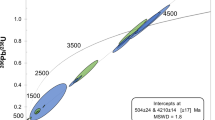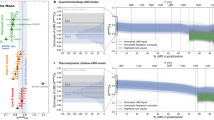Abstract
The asymmetry between the nearside and farside of the Moon is evident in the distribution of mare basalt1, crustal thickness2 and concentrations of radioactive elements3, but its origin remains controversial. According to one attractive scenario, a gigantic impact early in the Moon’s history produced the observed dichotomy; the putative 3,000-km-diameter Procellarum basin has been suggested to be a relic of this ancient impact3,4,5. Low-calcium pyroxene can be formed during an impact by melting a mixture of crust and mantle materials6,7 or by excavating differentiated cumulates from the lunar magma ocean8. Therefore, the association of low-calcium pyroxene with a lunar basin could indicate an impact origin. Here we use spectral mapping data from KAGUYA/SELENE (ref. 9) to show that low-calcium pyroxene is concentrated around two established impact structures, the South Pole–Aitken and Imbrium basins. In addition, we detect a high concentration of low-calcium pyroxene at Procellarum, which supports an impact origin of the ancient basin. We propose that, in forming the largest known basin on the Moon, the impact excavated the nearside’s primary feldspathic crust, which derived from the lunar magma ocean. A secondary feldspathic crust would have later recrystallized from the sea of impact melt, leading to two distinct sides of the Moon.
This is a preview of subscription content, access via your institution
Access options
Subscribe to this journal
Receive 12 print issues and online access
$259.00 per year
only $21.58 per issue
Buy this article
- Purchase on Springer Link
- Instant access to full article PDF
Prices may be subject to local taxes which are calculated during checkout




Similar content being viewed by others
References
Head, J. W. III & Wilson, L. Lunar mare volcanism: Stratigraphy, eruption, conditions, and the evolution of secondary crusts. Geochim. Cosmochim. Acta 56, 2155–2174 (1992).
Ishihara, Y. et al. Crustal thickness of the Moon: Implications for farside basin structures. Geophys. Res. Lett. 36, L19202 (2009).
Feldman, W. C. et al. Global distribution of lunar composition: New results from Lunar Prospector. J. Geophys. Res. 107, 5016 (2002).
Whitaker, E. A. The lunar Procellarum basin, in multi-ring basins. LPSC12, Part A (1981).
Byrne, C. J. A large basin on the near side of the Moon. Earth Moon Planets 101, 153–158 (2007).
Hess, P. C. Petrogenesis of lunar troctolites. J. Geophys. Res. 99, 19083–19093 (1994).
Warren, P. H., Claeys, P. & Cedillo-Pardo, E. in The Cretaceous-Tertiary Event and Other Catastrophes in Earth History. Boulder, Colorado (eds Ryder, G., Fastovsky, D. & Gartner, S.) (Geological Society of America, Special Paper 307, 1996).
Elkins-Tanton, L. T., Burgess, S. & Yin, Q-Z. The lunar magma ocean: Reconciling the solidification process with lunar petrology and geochronology. Earth Planet. Sci. Lett. 304, 326–336 (2011).
Matsunaga, T. et al. Discoveries on the lithology of lunar crater central peaks by SELENE Spectral Profiler. Geophys. Res. Lett. 35, L23201 (2008).
Garrick-Bethell, I., Nimmo, F. & Wieczorek, M. A. Structure and formation of the lunar farside highlands. Science 330, 949–951 (2010).
Jutzi, M. & Asphaug, E. Forming the lunar farside highlands by accretion of a companion moon. Nature 476, 69–72 (2011).
Nimmo, F. et al. Implications of an impact origin for the martian hemispheric dichotomy. Nature 453, 1220–1223 (2008).
Cintala, M. J. & Grieve, R. A. F. Scaling impact-melt and crater dimensions: Implications for the lunar cratering record. Meteor. Planet. Sci. 33, 889–912 (1998).
Lucey, P. G., Taylor, G. J., Hawke, B. R. & Spudis, P. D. FeO and TiO2 concentrations in the South Pole-Aitken basin—implications for mantle composition and basin formation. J. Geophys. Res. 103, 3701–3708 (1998).
Pieters, C. M. et al. Rock types of South Pole-Aitken basin and extent of basaltic volcanism. J. Geophys. Res. 106, 28001–28022 (2000).
Hess, P. C. & Parmentier, E. M. A model for the thermal and chemical evolution of the Moon’s interior: Implications for the onset of mare volcanism. Earth Planet. Sci. Lett. 134, 501–514 (1995).
Spray, J. G., Thompson, L. M., Biren, M. B. & O’Connell-Cooper, C. The Manicouagan impact structure as a terrestrial analogue site for lunar and martian planetary science. Planet. Space Sci. 58, 538–551 (2010).
Yamamoto, S. et al. Possible mantle origin of olivine around lunar impact basins detected by SELENE. Nature Geosci. 3, 533–536 (2010).
Tompkins, S. & Pieters, C. M. Mineralogy of the lunar crust: Results from Clementine. Meteor. Planet. Sci. 34, 25–41 (1999).
Spudis, P. D., Hawke, B. R. & Lucey, P. G. Proc. of 18th Lunar and Planetary Science Conference 155–168 (Cambridge Univ. Press, 1988).
Pieters, C. Noritic anorthosite is the most common highland rock type seen on the surface of the lunar nearside. Rev. Geophys. 24, 57–588 (1986).
Jolliff, B. L. et al. Major lunar crustal terranes: Surface expressions and crust-mantle origins. J. Geophys. Res. 105, 4197–4216 (2000).
Gancarz, A. J., Albee, A. L. & Chodos, A. A. Comparative petrology of Apollo 16 sample 68415 and Apollo 14 samples 14276 and 14310. Earth Planet. Sci. Lett. 16, 307–330 (1972).
Shearer, C. K. & Papike, J. J. Early crustal building processes on the moon: Models for the petrogenesis of the magnesian suite. Geochim. Cosmochim. Acta 69, 3445–3461 (2005).
Nakamura, R. et al. Ultramafic impact melt sheet beneath the South Pole-Aitken basin on the Moon. Geophys. Res. Lett. 362, L22202 (2009).
Wieczorek, M. A. & Le Feuvre, M. Did a large impact reorient the Moon? Icarus 200, 358–366 (2009).
Wieczorek, M. A. & Phillips, R. J. The Procellarum KREEP terrane: Implications for mare volcanism and lunar evolution. J. Geophys. Res. 105, 20417–20430 (2000).
Ohtake, M. et al. The global distribution of pure anorthosite on the Moon. Nature 461, 236–240 (2009).
Mohit, P. S. & Phillips, R. J. Viscoelastic evolution of lunar multiring basins. J. Geophys. Res. 111, E12001 (2006).
Klima, R. L. et al. New insights into lunar petrology: Distribution and composition of prominent low-Ca pyroxene exposures as observed by the Moon Mineralogy Mapper. J Geophys. Res. 116, E00G06 (2011).
Isaacson, P. J. & Pieters, C. M. Northern imbrium noritic anomaly. J Geophys. Res. 114, E09007 (2009).
Acknowledgements
The images and spectra used here were acquired by the JAXA lunar orbiter KAGUYA/SELENE. We thank Fujitsu and the JASCO Corporation for their dedicated efforts in developing the Spectral Profiler.
Author information
Authors and Affiliations
Contributions
R.N. and S.Y. performed the spectral analysis and model calculations. S.Y., T.M., Y.Y. and Y.O. carried out the data reduction and instrument calibration. S.Y. and N.H. contributed to the qualitative estimate of the impact melt production. T.H. contributed to the comparison of the spaceborne lunar spectra and laboratory spectra of returned Apollo samples. Y.I., T.M., H.T. and K.S. solidified the results of this paper from geophysical and mineralogical points of view. T.M. and M.O. served as principal investigators to acquire the images and spectra from the Spectral Profiler and the Multiband Imager onboard KAGUYA. R.N., S.Y. and T.M. worked jointly to write the paper. All authors discussed the interpretation of the results and commented on the manuscript.
Corresponding author
Ethics declarations
Competing interests
The authors declare no competing financial interests.
Supplementary information
Supplementary Information
Supplementary Information (PDF 1045 kb)
Rights and permissions
About this article
Cite this article
Nakamura, R., Yamamoto, S., Matsunaga, T. et al. Compositional evidence for an impact origin of the Moon’s Procellarum basin. Nature Geosci 5, 775–778 (2012). https://doi.org/10.1038/ngeo1614
Received:
Accepted:
Published:
Issue Date:
DOI: https://doi.org/10.1038/ngeo1614
This article is cited by
-
Analysis of mineral compositions and crater morphology on the Moon surface using Moon orbital satellite data
Journal of the Geological Society of India (2016)
-
Structure and evolution of the lunar Procellarum region as revealed by GRAIL gravity data
Nature (2014)



